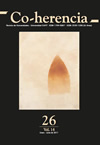Teología y experiencia estética: el lugar de la imagen frente a la noción de Revelación de Martín Lutero y Juan Calvino
Main Article Content
Keywords
Imagen, experiencia estética, revelación, Martín Lutero, Juan Calvino
Resumen
Este trabajo pretende argumentar que la concepción luterana y calvinista de la Revelación hace innecesario pensar la imagen como el lugar de lo sagrado. El postulado luterano de la justificación por la fe y el postulado calvinista de la doble predestinación descansan en una forma muy particular de entender la Revelación, que escinde al ser humano en dos dimensiones radicalmente diferentes: la espiritual y la corporal. Esa escisión tiene, a su vez, una distinción gemela: la separación entre lo público y lo privado. Ante ese esquema, la imagen se encuentra en una posición paradójica que solo puede resolverse cuando la experiencia de la imagen se empieza a pensar como una experiencia estética, es decir, autónoma. Esta experiencia se manifiesta en la creación y la apreciación o percepción de la obra.
Descargas
Los datos de descargas todavía no están disponibles.
Referencias
Belting, H. (1994). Likeness and Presence. A History of the Image before the Era of Art. Chicago - London: The University of Chicago Press.
Calvin, J. (2006a). Institutes of Christian Religion, Volume I. Louisville: The Westminster Press.
Calvin, J. (2006b). Institutes of Christian Religion, Volume II. Louisville: The Westminster Press.
Freedberg, D. (1986). Art and Iconoclasm, 1525-1580. The Case of the northern Netherlands. En J. P. Filedt, W. Halsema-Kubes & W. Th. Kloek (Redactie), Kunst voor de Beeldenstorm. Noordnederlandse Kunst 1525-1580: catalogus (pp. 69-84). Amsterdam: Rijksmuseum.
Gombrich, E. (1997). La historia del arte. Londres: Phaidon.
Hesselink, I. J. (2004). Calvin’s Theology. En D. K. McKim (Ed.), The Cambridge Companion to John Calvin (pp. 79-92). Cambridge: Cambridge University Press.
John of Damascus (1994a). John of Damascus, Exposition of the Ortodox Faith (rev. ca. 743). En H. Belting & E. Jephcott, Likeness and Presence. A History of Image before the Era of Art (pp. 503-504). Chicago - London: The University of Chicago Press.
John of Damascus (1994b). John of Damascus, Three Discourses on Sacred Images (ca. 730). En H. Belting & E. Jephcott, Likeness and Presence. A History of Image before the Era of Art (pp. 504-505). Chicago - London: The University of Chicago Press.
Karlstadt, A. (1994). Karlstadt, justifying the breaking of images (1522). En H. Belting & E. Jephcott, Likeness and Presence: A History of the Image before the Era of Art (p. 546). Chicago - London: The University of Chicago Press.
Largier, N. (2009). Mysticism, Modernity and the Invention of Aesthetic Experience. Representations, 105(1), 37-60.
Lutero, M. (1977a). Controversia sobre el valor de las indulgencias (1517). Las 95 tesis. En M. Lutero, Obras (pp. 62-69). Salamanca: Sígueme.
Lutero, M. (1977b). Controversia de Heidelberg (1518). En M. Lutero, Obras (pp. 74-85). Salamanca: Sígueme.
Lutero, M. (1977c). La libertad del cristiano (1520). En M. Lutero, Obras (pp. 155-170). Salamanca: Sígueme.
Lutero, M. (1977d). Artículos de Schmalkalda (1537-1538). En M. Lutero, Obras (pp. 332-357). Salamanca: Sígueme.
Luther, M. (1989). The Bondage of the Will. En M. Luther, J. Pelikan
& T. F. Lull, Martin Luther’s basic theological writings (pp. 138-170).
Minneapolis: Fortress Press.
Luther, M. (1994). Luther’s reply (1522, 1525). En H. Belting & E. Jephcott, Likeness and Presence: A History of Image before the Era of Art (pp. 545-546). Chicago - London: The University of Chicago Press.
Wriedt, M. (2003). Luther’s Theology. En D. K. McKim (Ed.), The Cambridge Companion to Martin Luther (pp. 86-119). Cambridge: Cambridge University Press.
Calvin, J. (2006a). Institutes of Christian Religion, Volume I. Louisville: The Westminster Press.
Calvin, J. (2006b). Institutes of Christian Religion, Volume II. Louisville: The Westminster Press.
Freedberg, D. (1986). Art and Iconoclasm, 1525-1580. The Case of the northern Netherlands. En J. P. Filedt, W. Halsema-Kubes & W. Th. Kloek (Redactie), Kunst voor de Beeldenstorm. Noordnederlandse Kunst 1525-1580: catalogus (pp. 69-84). Amsterdam: Rijksmuseum.
Gombrich, E. (1997). La historia del arte. Londres: Phaidon.
Hesselink, I. J. (2004). Calvin’s Theology. En D. K. McKim (Ed.), The Cambridge Companion to John Calvin (pp. 79-92). Cambridge: Cambridge University Press.
John of Damascus (1994a). John of Damascus, Exposition of the Ortodox Faith (rev. ca. 743). En H. Belting & E. Jephcott, Likeness and Presence. A History of Image before the Era of Art (pp. 503-504). Chicago - London: The University of Chicago Press.
John of Damascus (1994b). John of Damascus, Three Discourses on Sacred Images (ca. 730). En H. Belting & E. Jephcott, Likeness and Presence. A History of Image before the Era of Art (pp. 504-505). Chicago - London: The University of Chicago Press.
Karlstadt, A. (1994). Karlstadt, justifying the breaking of images (1522). En H. Belting & E. Jephcott, Likeness and Presence: A History of the Image before the Era of Art (p. 546). Chicago - London: The University of Chicago Press.
Largier, N. (2009). Mysticism, Modernity and the Invention of Aesthetic Experience. Representations, 105(1), 37-60.
Lutero, M. (1977a). Controversia sobre el valor de las indulgencias (1517). Las 95 tesis. En M. Lutero, Obras (pp. 62-69). Salamanca: Sígueme.
Lutero, M. (1977b). Controversia de Heidelberg (1518). En M. Lutero, Obras (pp. 74-85). Salamanca: Sígueme.
Lutero, M. (1977c). La libertad del cristiano (1520). En M. Lutero, Obras (pp. 155-170). Salamanca: Sígueme.
Lutero, M. (1977d). Artículos de Schmalkalda (1537-1538). En M. Lutero, Obras (pp. 332-357). Salamanca: Sígueme.
Luther, M. (1989). The Bondage of the Will. En M. Luther, J. Pelikan
& T. F. Lull, Martin Luther’s basic theological writings (pp. 138-170).
Minneapolis: Fortress Press.
Luther, M. (1994). Luther’s reply (1522, 1525). En H. Belting & E. Jephcott, Likeness and Presence: A History of Image before the Era of Art (pp. 545-546). Chicago - London: The University of Chicago Press.
Wriedt, M. (2003). Luther’s Theology. En D. K. McKim (Ed.), The Cambridge Companion to Martin Luther (pp. 86-119). Cambridge: Cambridge University Press.




